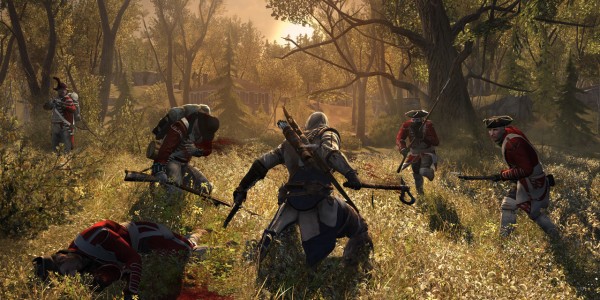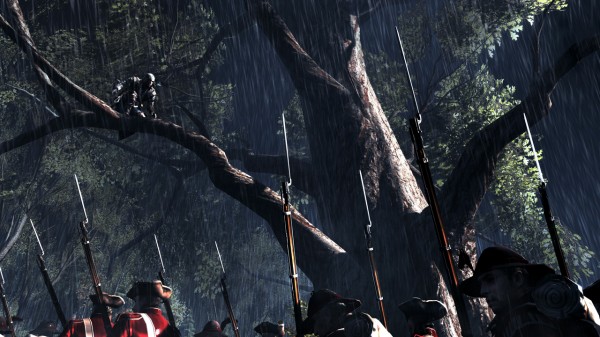The sun hangs wearily in the afternoon sky overlooking Bunker Hill, clouded by the smoke from thousands of spent muskets. Ubisoft Montreal Creative Director Alex Hutchinson explains that this is just one of a handful of poignant moments in the American Revolution that players will see through the eyes of Connor Kenway, or his Mohawk name, Ratohnhaké:ton. Half-English and half-Native American, Connor has a distinct perspective looking in from the outside of the colonial conflict that dominated late 18th-century America (then 13 separate colonies). A gameplay demo at PAX East 2012 offers a glimpse into the guerrilla tactics the Assassin’s Creed III protagonist will use to save his homeland and discover the truth about the Templars.
Ubisoft Montreal first sets the tone of The Battle of Bunker Hill – a Pyrrhic victory for the British – by leading Connor through a group of colonial militia rallying to General William Prescott’s famous “whites of their eyes” speech. Connor passes the troops, crests a nearby hill, and sees the full scale of the battle. For a quarter of a mile, the landscape is covered with red and blue corpses, boxed on either side by leagues (2,500 figures altogether) of orderly British firing lines and Americans clinging to nearby cover. Smoke fills the air above the battle as the the rifles fire in unison, the interspersed greenery in contrast to the mechanisms of war. The effect is staggering, especially for a series so dutifully tied to ancient urban settings.
Hutchinson brings the demo back to speed, explaining that players will choose how to approach these battles. In this instance, a path to the right will unfold with more breakneck, head-on action while the leftward path favors stealth. Connor ducks between the cover of large rocks to advance to the left, pausing to avoid the predictable, infrequent iron volleys. Reactive movement systems become apparent as he staggers from a nearby cannonball explosion. The animations for individual characters and battle-scale animations create a believable, brutal scene.
Once at the treeline, Connor takes to the limbs. Whereas Desmond Miles’ other ancestors spent more time scaling ordered architecture, the world of colonial America is too underdeveloped for much building traversal. As such, the navigation systems of Assassin’s Creed III have been built around the organic structures of trees and rock faces that dominate the field. It was important, Hutchinson remarks, for the team to get the feel of the flora correct, so traversal won’t be one parallel branch to the next. Rather, Connor will naturally swing around trunks, climb up awkward branches, hoist himself into the crotch of a splitting tree, and amble across limbs deftly without requiring more than the expected player input. The same holds true for craggy cliffs.
Connor halts the squirrel business when overlooking a dirt path and six approaching British soldiers. Not to be outdone by the disemboweling abilities of Ezio’s wrist-hook, Connor breaks out the rope-dart, a sinister hanging mechanism as simple as it is effective. He spears the nearest redcoat with the metal end of the device, then swiftly hoists the hapless soldier’s body to hang from the tree as he descends the line to face the other opponents. Outnumbered and staring down the barrel of four readied muskets, Connor grabs the nearest soldier to use as a bullet shield. After using the corpse to absorb the pellets, Connor closes the gap and shows off his melee prowess, combining dual counters with pistol and hatchet play. It’s not long before the Brits are dispatched, and Connor makes for the nearby cliff at the base of the enemy’s camp.
The demo finishes a stealthy assault on the British Commander John Pitcairn, mounted atop his horse and surrounded by armed troops. To get into prime striking position, Connor climbs to the back of the camp and navigates around a few tents using the game’s new “stalking zones,” in this case a short, dense thicket. Once in place, Connor charges straight towards the Commander, cutting down three British guards while maintaining full forward motion. The last slice of the hatchet falls on Pitcairn, and the demo comes to a halting end.
Accurately representing the American Revolution through play mechanics is no small challenge, especially coming from a lineage of games focused on more organized environmental traversal and “gamey” setups involving guards and fortresses. Ubisoft Montreal shows in this demo that Assassin’s Creed III is a project dedicated to exploring an authentic historical landscape and the “predator fantasy” at the core of the series’ gameplay. Bunker Hill is a an example of an action-packed set piece, and the downtime taking up the majority of the previous games remains a real question for a virtual civilization with fewer, smaller settlements. If the rest of the game gets the same detail-oriented, epic crowd, full-scale stealth-action attention that this short segment received, fans and history buffs will have a lot to look forward to when the game releases on October 30 for the Xbox 360, PlayStation 3, and PC.




















2 Comments on "Assassin’s Creed III Preview"